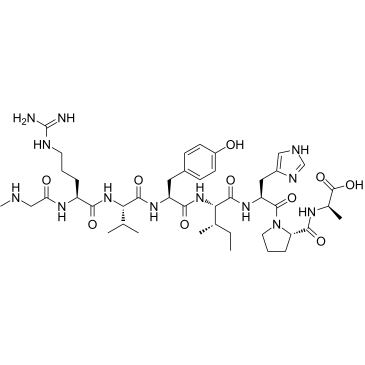| Description |
TRV120027, a β-arrestin-1-biased agonist of the angiotensin II receptor type 1 (AT1R), engages ß-arrestins while blocking G-protein signaling[1]. TRV120027 induces acute catecholamine secretion through cation channel subfamily C3 (TRPC3) coupling, promotes the formation of a macromolecular complex composed of AT1R–β-arrestin-1–TRPC3–PLCγ at the plasma membrane. TRV120027 inhibits angiotensin II–mediated vasoconstriction and increases cardiomyocyte contractility. TRV120027 has the potential for the acute decompensated heart failure (ADHF) treatment[2].
|
| Related Catalog |
|
| Target |
IC50: the angiotensin II receptor type 1 (AT1R)[1]
|
| In Vitro |
TRV120027 (100 nM) significantly increases the AT1R and TRPC3 association with the immunoprecipitated β-arrestin-1 in HEK293 cells co-transfected with Flag-AT1R-cherry, HA-β-arrestin-1 and TRPC3-GFP[2]. TRV120027 (100 nM) induces an [Ca2+]i increase in HEK293 cells co-transfected with AT1R, β-arrestin-1, and TRPC3, which are significantly blocked by Pyr3 pre-incubation in HEK293 cells co-transfected with Flag-AT1R-Cherry, HA-β-arrestin-1, and TRPC3-GFP[2].
|
| In Vivo |
TRV120027 (intravenous injection; 0.3 or 1.5 µg/kg per minute; infusion rate, 0.5 mL/min) when added to furosemide decreases cardiac preload and afterload, systemic and renal vascular resistances, and left ventricular external work while increasing cardiac output and renal blood flow. GFR and renal excretory function are maintained in canines with experimental HF[1]. Animal Model: Male mongrel dogs (weight, 20.5–30 kg)[1] Dosage: 0.3 or 1.5 µg/kg per minute; infusion rate, 0.5 mL/min Administration: Intravenous injection Result: Resulted in dose-dependent vasodilation, increased cardiac contractility, and decreased myocardial oxygen consumption in dog.
|
| References |
[1]. Boerrigter G, et al. TRV120027, a novel β-arrestin biased ligand at the angiotensin II type I receptor, unloads the heart and maintains renal function when added to furosemide in experimental heart failure.Circ Heart Fail. 2012 Sep 1;5(5):627-34. Epub 2012 Aug 13. [2]. Liu CH, et al. Arrestin-biased AT1R agonism induces acute catecholamine secretion through TRPC3 coupling.Nat Commun. 2017 Feb 9;8:14335.
|
